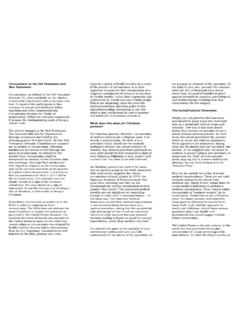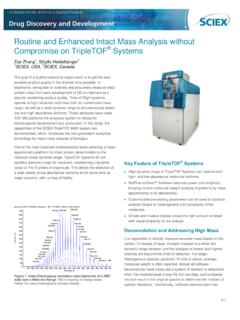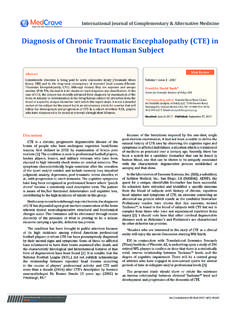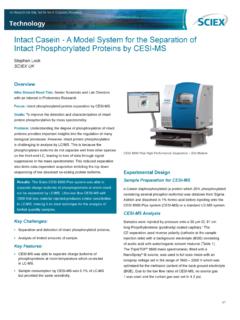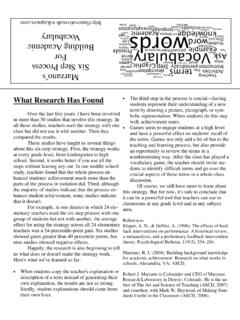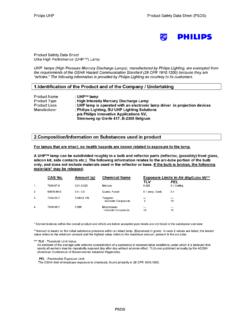Transcription of ANATOMY AND PHYSIOLOGY OF THE INTACT PENIS
1 ANATOMY AND PHYSIOLOGY OF THE INTACT PENIS Contains diagrams and photographs of penile ANATOMY for educational purposes only. 1 THE INTACT PENIS : NOT JUST A FLAP OF SKIN The foreskin is not a flap of skin, but a double-layered fold of skin. It is an integral part of the penile skin system. It is a continuation of the shaft skin which extends forward over the head (glans) of the PENIS , then folds back under itself to attach to the shaft in the groove (sulcus) behind the glans. Source: EMBRYOLOGY The glans PENIS in males and the clitoris in females are intended to be internal structures. They both develop with a moveable protective covering, the foreskin. 3 DEVELOPMENT IN UTERO The foreskin begins to develop at 8 weeks of gestation. It starts as a doubling over of a roll of skin at the base of the glans. It grows in this double layer forward over (and generally beyond) the glans.
2 The foreskin is fused to the glans in utero by a common epithelial cell layer, known as the synechia (black areas in this diagram). The development of the foreskin is complete by 24 weeks gestation. Leading edge of foreskin fold growing forward over glans in fetus. 4 THE NORMAL INFANT PENIS Newborn Infant The foreskin gradually separates from the glans over the early years of life. The process is very variable, and completes itself sometime between birth and the end of adolescence. 5 6 FUNCTIONS OF THE FORESKIN SEXUAL 1. Serves as erogenous tissue, especially via the ridged band and Meissner's corpuscles 2. Acts as a rolling bearing in intercourse and masturbation, decreasing abrasion and increasing comfort for both partners 3. Facilitates intromission (insertion of the PENIS ) 4. Stimulates partner's genitalia, giving erotic pleasure 5.
3 Allows for motions of intercourse to be shorter and gentler, and provide closer contact to female partner s pubic mound 6. Supplies sufficient skin to comfortably cover the shaft during erection 7. Stores and releases natural lubricants (pre-ejaculatory fluid) 8. Helps retains natural lubricants within vagina on the outstroke 9. Makes the glans a visual signal of sexual arousal 10. Provides a seal against the vaginal wall to contain semen PROTECTIVE 11. Prevents the glans becoming keratinised, keeps glans soft and moist 12. Protects the glans against injury 13. Protects the nerves of the glans, maintaining their erotic function 14. In infancy, protects the glans and urinary opening from contamination 15. In infancy, protects the urinary opening from inflammation, ulceration, and stenosis 16. Provides lysozymes and other immunological factors for bacteriostatic action around the glans 17.
4 Protects the glans against sunburn 18. The foreskin is highly vascular (rich in blood vessels that bring warmth to the tissues), and protects the less vascular glans against cold and frostbite (as Sir Ranulph Fiennes found on his epic transpolar walk). THE FORESKIN MAY WELL HAVE OTHER FUNCTIONS THAT ARE AS YET UNDISCOVERED. 7 THE INTACT ADULT PENIS Foreskin covering the glans; the foreskin when retracted; and a closeup of the foreskin covering the glans. Same views with added color-coding of anatomical features. Cross-section shows the double layer of foreskin covering glans. The frenar band is elastic tissue at the foreskin tip (between the inner and outer foreskin) that helps to contract the tip of the foreskin and allow it to remain positioned over the glans. Many INTACT men find this band very erogenous. 8 THE FRENULUM (FRENUM) The frenulum is elastic tissue that connects the foreskin to the underside of the glans and helps keep the foreskin forward over the glans.
5 Many INTACT men find this a highly erogenous part of the PENIS . It is often partially or totally removed by circumcision. The outer foreskin is similar to the skin of the shaft skin. The inner foreskin is mucous membrane, as is the surface of the glans. The mucosal surface of the foreskin and glans is similar to that of the female labia and vagina. Together, the inner and outer foreskin account for over 50% of the penile skin -- in an adult, an area of approximately 15 square inches. 9 THE RIDGED BAND The ridged band is a ring of deeply corrugated or ridged mucous membrane lining the tip of the foreskin. When the foreskin is retracted, the main part of the ridged band lies across the top and sides of the shaft of the PENIS . On the underside of the PENIS , the ridged band merges into the frenulum of the foreskin. The ridged band contains the highest concentrations of light touch receptors of any part of the PENIS , making it is a sensitive as the lips or the fingertips.
6 Stretching of the accordion-like ridged band triggers important sexual reflexes and erogenous sensation. 10 LENGTH OF THE FORESKIN The length of the foreskin is very variable. In some males, the foreskin may only partially cover the glans (above). In others, the foreskin extends well past the tip of the glans, forming a tubular overhang (above). This overhang is a normal phenomenon which helps protect the glans and urinary opening by increasing the distance from the outside environment. The overhang of babies provides extra skin for the PENIS to grow into as the child matures. 11 FORESKIN MOBILITY AND RETRACTION The range of skin movement marked by point A (black) is several inches back and forth. Note how point B (white) moves and the end of the foreskin widens to accommodate the head of the PENIS . The skin of the PENIS is not tethered to the underlying penile structures, except at two points -- at the pubic bone and at the coronal sulcus (behind the glans).
7 The penile skin -- including the two layers of the foreskin -- is thus able to glide freely over the penile shaft. With slight traction towards the body, the foreskin can easily unfold, turn inside out, and retract behind the glans. Note how the ridged band unfurls along the shaft with retraction. 12 THE THREE ZONES OF PENILE SKIN These five photos show the three zones of skin on a normal, INTACT (non-circumcised) adult PENIS : 1. the SHAFT SKIN (the area above the upper line in each photo) 2. the OUTER FORESKIN FOLD (the area between the two lines) 3. the INNER FORESKIN FOLD (the area below the lower line), visible only when the foreskin is retracted. a. b. c. d. e. The upper line marks the level of the corona of the glans. This line represents the imaginary limit of the outside fold of the foreskin (it is actually a seamless continuation of the rest of the shaft skin).
8 This is approximately the line where the foreskin is amputated during circumcision. The lower line marks the level of the foreskin s opening in the flaccid PENIS . This line represents the junction where the skin of the outer foreskin fold changes over to the mucous membrane of the inner foreskin fold (the muco-cutaneous junction). 13 DESCRIPTIONS OF ABOVE PICTURES a. The area between the upper line and the lower line is the foreskin's outside fold. It is continuous with and of the same type of skin as the shaft skin. b. The foreskin manually retracted about an inch. Inner foreskin fold begins to be seen. Note the reddish, glistening surface of the mucous membrane surface of the inner foreskin and glans. c. The foreskin retracted. The ridged bands of the inner foreskin fold are gathered in the sulcus behind the glans. d. The foreskin retracted farther. Almost the entire penile shaft is now covered with foreskin.
9 If the skin were released, it would return to its position in photo c . Note the reddish vascular blush of the inner foreskin. e. The foreskin manually retracted as far as it will comfortably go. The area between the lower line (the only line now visible) and the glans is the foreskin's fully retracted inside fold. The entire penile shaft is now covered with foreskin. THESE PHOTOS DEMONSTRATE: The extensive surface area of the foreskin The mobility of the INTACT penile skin system The elasticity of the penile skin The vascularity of the foreskin The smooth texture of the protected glans The distinction between outer skin and inner mucous membrane surfaces14 THE RETRACTION PROCESS As it changes from flaccidity to rigidity with erection, the PENIS increases in length about 50%. As it elongates, the double fold of skin (foreskin) provides the skin necessary for full expansion of the penile shaft.
10 The skin of the INTACT PENIS is sufficient to maintain a wide range of mobility with sexual activity. 15 INTERCOURSE AND THE INTACT PENIS Only with the presence and functions of the prepuce is physiologically normal coitus able to occur as designed by nature. During intercourse the mobile skin of the INTACT PENIS slides up and down the shaft of the PENIS , simultaneously stimulating the glans and the sensitive erogenous receptors of the foreskin itself. On the outstroke, the glans is partially or completely engulfed by the foreskin. This gliding mechanism serves to reduce friction with the motions of intercourse. This is nature's intended mechanism of intercourse, and as such, it contributes greatly to sexual comfort and pleasure. Also, since more of the loose skin of the PENIS remains inside the vagina on the outstroke, the woman's natural lubrication is not drawn out to evaporate, making sex easier without having to use artificial lubricants.
